I have really enjoyed my plays of several solitaire games designed by R. Ben Madison. He has a knack for including elements of the history into the gameplay while placing the events into the framework of his chosen system, which is usually the States of Siege Series…but not necessarily always. His newest offering is called Gift of the Nile: The Rise & Fall of Ancient Egypt from White Dog Games and is a solitaire only game that uses the States of Siege Series System and delves into Ancient Egypt and the rule of the Pharaohs covering over 30 dynasties starting with the Old Kingdom in 2600 BC to the Late Period starting in 700 BC and ending with the intervention of Rome. This is a long and involved game (ranging from 36 turns to something less based on certain conditions happening or a player loss) that really gives the player a good feel for the might and power of the Egyptians, as well as the various threats and enemies they had to deal with to survive for nearly 3,000 years.
In Action Point 1, we looked at the Game Map (board), which shows the various “Paths” used by the assaulting outside Khasti Kingdoms converging on the capital city of Men-Nefer. In Action Point 2, we investigated the purpose and makeup of the 3 different draw cups, which is where the game action starts including the Dynasty Cup, God Cup and Sepat Cup. In Action Point 3, we took a look at the Nile Phase and further discussed the economy of the game. In Action Point 4, we dove into the 4 different Eras or Kingdoms that the player must traverse through safely to come out on top and some of their unique aspects. In this Action Point, we will take a look at the various Actions that players can take during the Action Phase and why they are important.
Action Phase
The Action Phase is the meat of the game and is where the player gets to take things into their own hands and make choices about how they spend their Action Points and what they wish to accomplish on the Game Map. This phase is pretty wide open and provides a lot of different tools to the player to allow them to forge their own destiny. During the Action Phase, the player may conduct a number of Actions by spending their available Action Points (AP’s) as they would any currency. In the game, Action Points are earned through rolling 2D6 during the Nile Phase in 2 different ways. The first is a straight up roll where the player will take the highest single die result and subtract from it the lowest result. This gives a range of possible Action Points of 0 (if the player rolls doubles!) to 5 AP’s (6-1 = 5). I have found that this roll generally nets you only a few Action Points but the way that the player has more control over this number is the Trade Goods portion of the process where they will total the numbers on each die and then consult the Trade Goods Table to determine what goods are in demand and paying this turn. They then will gain a bonus Action Point for each of the Trade Goods listed that they either have a Templed Sepat under their control or for which they have 2 Untempled Sepats under their control. The player can also gain a few bonus Action Points from things like the Dynastic Social Skill (+1 AP) or as an Emergency 1 AP if they rolled doubles and didn’t gain any other AP from Trade Goods or bonuses. You will always have at least 1 AP but this will not be good enough and you will be unable to access the more costly Actions on the menu.
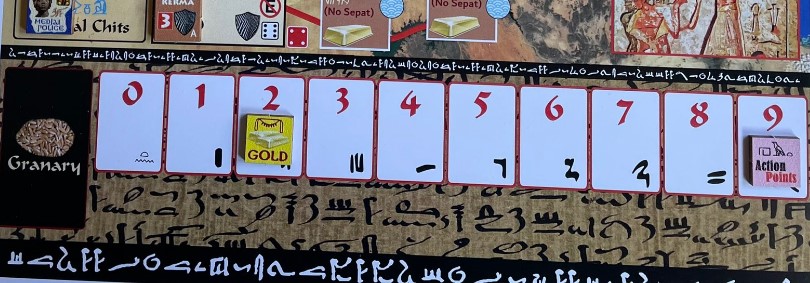
The number of Action Points is tracked by the player on the Granary Track found at the bottom of the Game Map. When an Action is chosen to perform, the player simply reduces their available Action Points on the Granary Track by the cost of the Action and then performs that Action, which typically involves rolling a D6 with some modifiers. The only real limit to the number of Actions that can be performed in a turn is whether you can afford them but there are some Actions that are only available during certain Eras or if the player has developed their Literacy beyond a certain point.
One other source of income is Gold as the player can obtain Gold to use to build their economy by controlling 2 Land Boxes on the Ta Seti Path. These Land Boxes are Irtjet and Wawat located at the end of the Ta Seti Path adjacent to the Ta Seti Country Box. These boxes are located in Nubia and represent the vast gold deposits and mines in this country. Control of these Land Boxes will provide the player with 1 Gold per Land Box each round so there is the potential to gain 2 Gold each round. Gold is a more flexible resource than Action Points and can be used to pay costs for building Heroes, repairing special troops such as the Chariots and also used as an Action Point. So, if you have done your work and control these gold fields, you will also gain an extra Gold or 2 each round that can supplement what you gain from the Nile Die Roll and Trade Goods.
Let’s go ahead and take a look at some of the major Actions. We have covered several of these in previous posts in the series, so we might only reference these and skip over their description.
Attack a Hostile Army
Once the game hits the Middle Kingdom Era, things begin to change as discussed in the last Action Point. Enemies will now appear on the Paths and when they are activated by Events or as a part of Evolution, they will relentlessly attack the player’s Sepats and will not stop until they are defeated or they reach their goal of Men-Nefer. This is when the player will have to use an Action Point to Attack this hostile army or Rival Dynasty Tile. To Attack a Hostile Army, the player will get to roll 1D6, which can be modified by various conditions, and if the roll exceeds the Army’s Value printed on the counter, they will defeat that hostile army and push them back one Land Box. If the hostile army was a Khasti, it is pushed out of the Land Box and the player will now control that area. If the target was a Rival Dynasty, the Rival Dynasty Tile will be removed from the Land Box and placed back into the supply. This will also regain control of this area. There is no limit to the number of times you can spend an Action Point to attack the same hostile army win or lose. You just spend another Action Point, choose the hostile army you want to attack again and roll. This is probably the action that the player will take the most during the game and it is very important. But, sometimes the dice can be unkind and you will simply have to suck it up and try again.
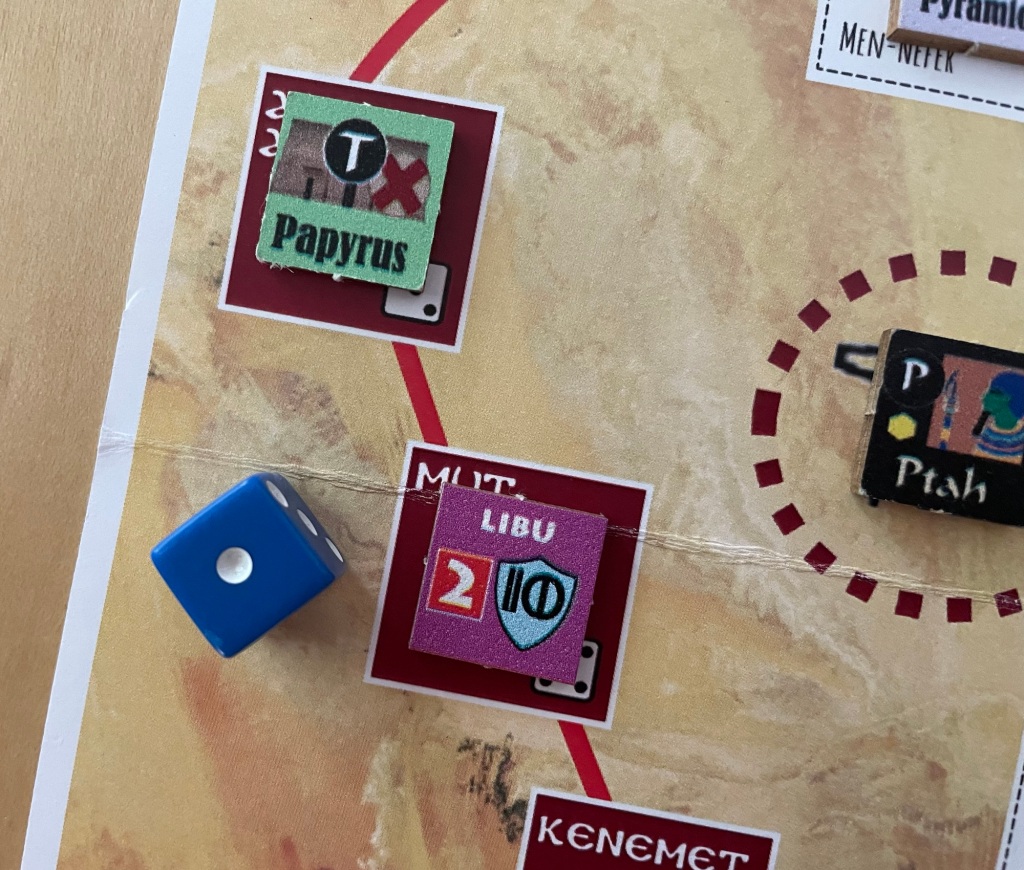
Two Dice Campaign Attacks
Sometimes you can upgrade a normal Attack Action to become a much better Campaign Attack. This will cost an Action Point as normal but will also require you to use Pharaoh. He has to be available in Men-Nefer and you simply place him in the Unavailable Box and then can take this Campaign Attack. A Campaign Attack is superior because it allows the player to roll 2D6 and use the best result of the 2 dice. During the Old Kingdom Era, each attack by the Medjai Troops is a Two Dice Campaign Attack but that benefit goes away at the beginning of the Middle Kingdom. You just have to keep in mind that using Pharoah is a once per round thing and when he is unavailable then you cannot use any of the other number of his benefits such as Templing a Sepat or building Walls of the Ruler or Megaprojects. He is a resource just the same as your limited Action Points and you have to use him wisely to come out on top.

I am a big believer in dice advantage in games. If you can do something that allows you to roll multiple or even larger dice for an action, you have to be willing to take this benefit. It is just that good as it increases your chances of success. And in a game that relies so much on the results of die rolls, these Campaign Attacks can be a life saver!
Invading a Country
One of the more important but costly actions available to players is the Invading a Country Action. This Action costs 3 AP’s but will also be something that has a lot of perquisites that you must work on over the period of the game. First, you must have increased your literacy to either Demotic or Coptic. Each of these levels allow the use of additional Actions such as Invading a Country or Buying Ma’at Tiles. Invading a Country allows the player to hold back the advance of the Khasti Army whose country they have invaded and forces them to deal with the internal strife first before continuing their invasions of Egypt. Next, Invading a Country requires the player to have driven back the Khasti Army on that Path to their Country Box at the end of the Path. They have to control the Land Box adjacent to the Country Box to quality for the attack. This is due to the great distances involved and routes and supply lines necessary to support an invasion.
The player then simply rolls an Attack as usual using their 1D6 and they have to roll higher than the value listed on the Khasti Army Counter. This is a good time to utilize Pharaoh to get a Two Dice Campaign Attack but the cost is not being able to use him later for other Actions. If the Attack is successful, the player will then place one of the two available light blue Egyptian Rule Tiles in the Country Box. The benefit here is that this Egyptian Rule Tile will absorb the next activation of that Khasti Army. When it is activated by an Event or Khasti Evolution, it will simply stay put and the Egyptian Rule Tile will be removed.

One other caveat. If the player is using this Action on the Ta Seti Country Box, which is where Nubia is located and is the Path that provides Gold resources to the player for controlling these Land Boxes, the cost for the Action increases to 4 AP’s. This is due to the great distance from Men-Nefer and how well defended it was by the Nubians. This is one of the more important Actions in the game and I like to think of their connection to the literacy requirement as being investment into language and literacy that has allowed the Egyptian ambassadors and spy networks to work behind the scenes in these distant lands to better learn and understand their weaknesses and how to exploit them allowing for this type of conquest and control. I find that I use this Action exclusively on the Ta Seti and Retjenu Countries as these are the ones that typically cause the most problems for the player or that have the best return on that investment.
Templing Sepats
The most important and key Actions in the game is that of Templing Sepats. As the player expands their empire and discovers rival dynasties and small kingdoms, in order for the Egyptians to gain benefit from these discoveries, they will have to conquer these lands and establish their rule through the development of infrastructure to encourage the movement and trade of valuable commodities such as Beer, Copper, Grain, Granite, Limestone, Linen, Natron, Papyrus and Turquoise. A Templed Sepat also will defend itself from the invasions of Khasti Armies whereas an undeveloped Sepat will not. This is where Templing Sepats come into play.
To Temple a Sepat, the player will spend a number of AP’s equal to the Sepat’s current face-up value and then flip that Sepat over to its improved Templed side. There is no die roll involved but this can be costly as more rare Trade Good producing Sepats, such as Granite, Turquoise and Natron will typically be valued at 3 or 4 and will cost 3 or 4 AP’s.

I want to stress that it is important to be frugal and efficient with this Action. The player has got to pay attention to several different factors to maximize their return with the Templing Sepats Action. The first point is to do this Action on Paths that are currently in Decline due to a Decline Tile having been placed on that Path during the God Phase. This will reduce the cost to Temple a Sepat by -1 AP. The second is to be aware of what Dynastic Skills the player currently has access to when the Dynasty Chit is placed out at the beginning of the round. If they have the Religious Skill this means that the current Dynasty can Temple a Sepat for just 1 Action Point one time per turn. Remember, this action normally takes an amount of Action Points equal to the value listed on the Sepat Chit between 1-4. You can also utilize Pharaoh to Temple a Sepat during the Old Kingdom Era for just 1 AP but this benefit will go away at the end of that Era.
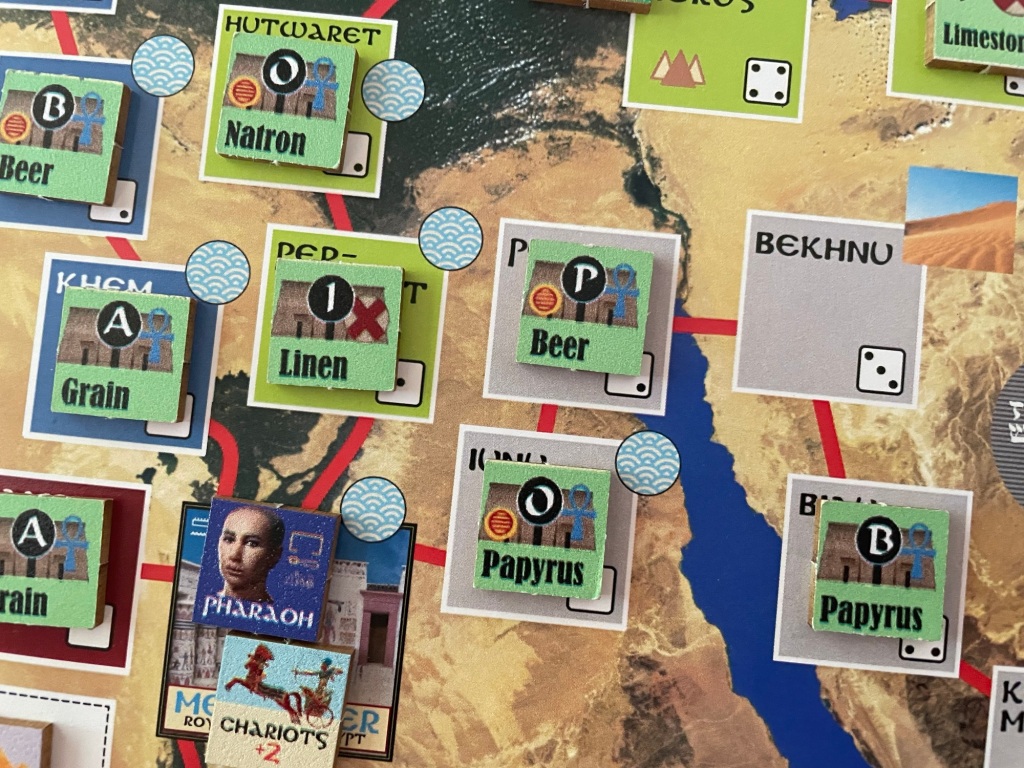
Colonization
The Colonization Action is also a very useful Action as you can use this to reestablish a Sepat in a Land Box where one was formally destroyed by invading Khasti Armies or even to place one into a Desert Box that normally will not have one unless you use this Action. You do have to control the Land Box but the process is very simple but risky. You have to risk a certain amount of AP’s and then reach into the Sepat Cup to take out a Sepat at random. If you have spent a number of AP’s greater than the printed value on the drawn Sepat Chit, you can then place that Sepat out into the target Land Box on its Untempled Side and you have successfully colonized it. If the printed value is higher than the AP’s you risked, you will have failed and the Sepat will be returned to the Sepat Cup. This is an Action that is best used early in the game as there will be several smaller valued Sepat Chits still remaining in the cup. But as the game wears on, and you have successfully conquered and placed Sepat Chits on the board from the Sepat Cup, it will get harder and harder to guess correctly. Sometimes you will find that there are only 3 or 4 valued Sepats left in the Sepat Cup and you will really have to consider how important it is to have to spend 4 or 5 AP’s to gain one new Sepat that you will ultimately have to spend another 3 or 4 AP’s to Temple before it will benefit you. It all comes down to time of the game, the situation on the board and the amount of Action Points you have for that turn.
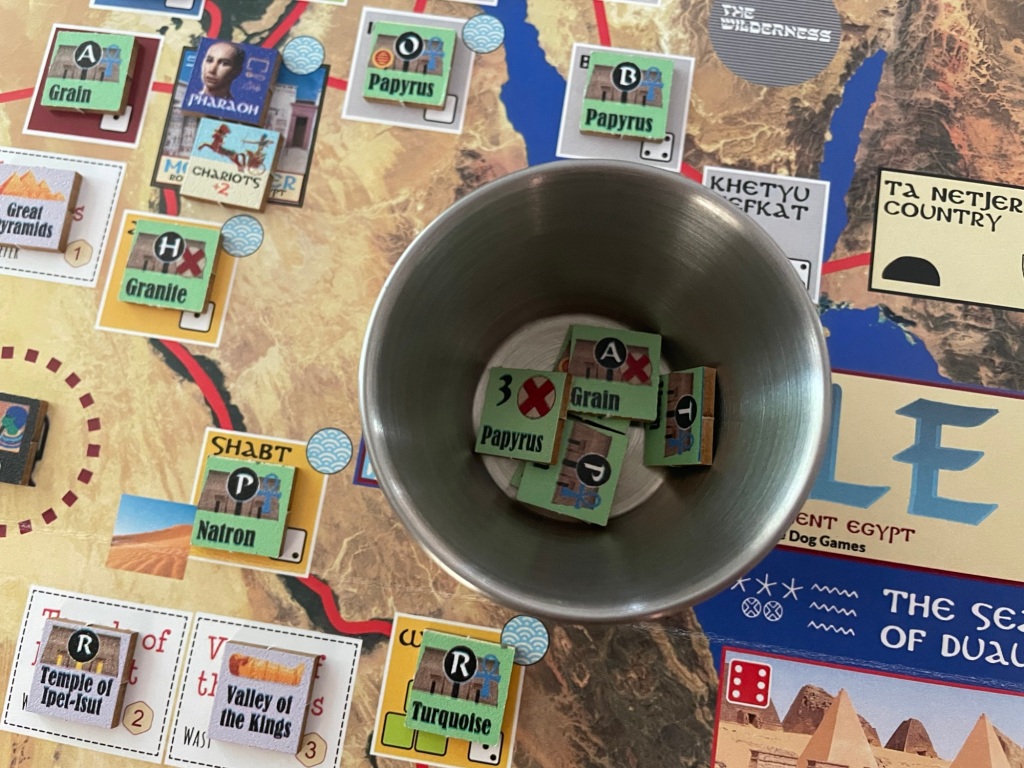
Megaprojects
There are 3 possible Megaprojects that the player can build on the board and Pharaoh must be used to complete this Action. These include the Pyramids, the Valley of the Kings and the Ipet-Isut Temple Complex. Each of these Megaprojects will cost 3 Action Points to build along with Pharaoh being available and then placed in the Unavailable Box and they must be built in order with the Pyramids first, followed by the Ipet-Isut Temple Complex and finally the Valley of the Kings. You also have to have control the Land Boxes where the Ipet-Isut Temple Complex and the Valley of the Kings are built at the time of the projects so you must control Wast.

When each of the Megaprojects are built the player may also spend up to 2 additional Action Points to purchase up to 2 Revival Chits for 1 AP each for each project. If they don’t or cannot buy them at the time of the project’s completion, they will lose this chance. Remember that the Revival Chits can be used to revive the civilization in the turn after Men-Nefer has fallen to an invading Khasti Army. If you don’t have a Revival Chit at this point, the game will come to an early end. Also Revival Chits are worth 7 Survival Points at the end of the game so any good strategy will involve them in your holdings. I find that I have to play this Action out a few rounds in advance to make sure I have the requisite AP’s, to not just build but to also purchase the Revival Chits, and Pharaoh is available.
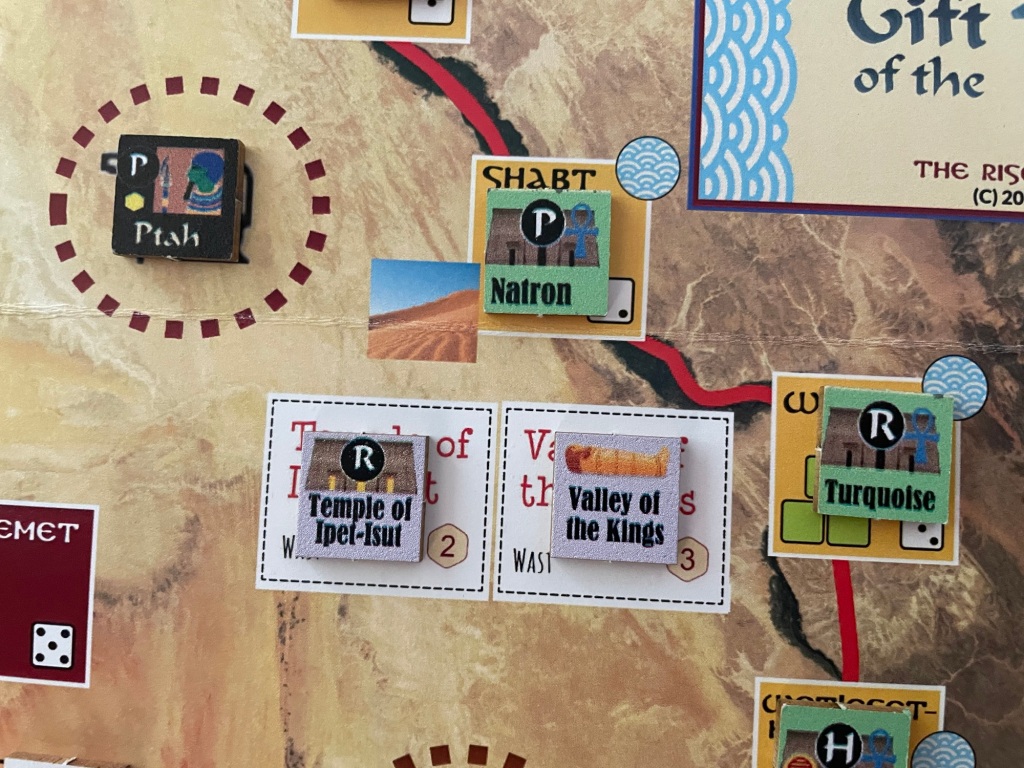
Marriage
During the New Kingdom Era, the player gets access to the Marriage Action which allows the player to place a Marriage Tile onto a Path on the board attempting to marry into an enemy’s family. The Action costs 2 AP’s and the tile can block the advance of the Khasti Army on that Path. But it will cost an additional amount of Action Points to actually be able to attempt to block that movement. The player has to spend a certain amount of AP’s, the amount is up to them, and then they have to roll a D6 and if the result is less than the AP’s spent, the Khasti Army is blocked from moving. I really don’t use this action that often and don’t particularly recommend its use. It does have some utility but it is costly.
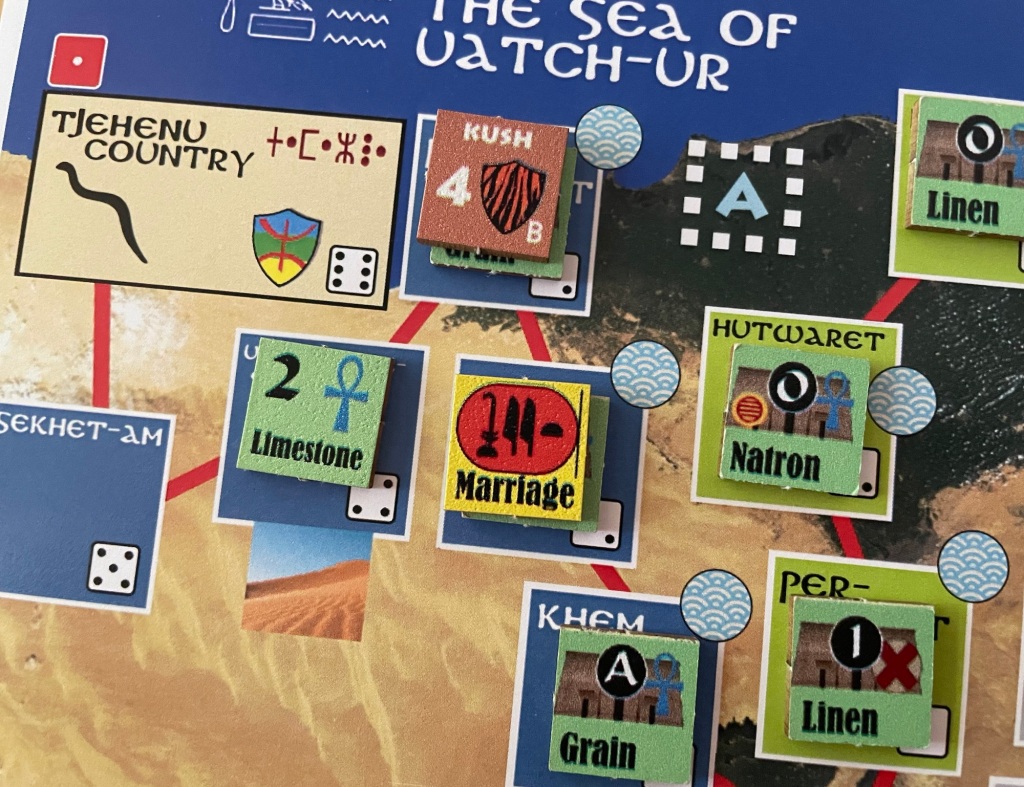
Hire the Medjai Police
Egypt was a land of great riches and many of those riches were hidden in ancient tombs, temples and other structures. There were many adventurers and grave robbers who would seek out these riches and attempt to steal them. This is where the Medjai Police come in handy. The player can spend 2 AP to build the Medjai Police unit and place it in the Revival Chits Box on the board. Any time that the Tomb Robbers event is rolled on the Chronicles of Manetho, the Medjai Police unit is a persistent guard against these attempts and can block their grave robbing. The player simply rolls a D6 and if a 6 is the result, the grave robbers succeed and take 1 of your Revival Chits and destroy the Medjai Police unit. It can be rebuilt by the player spending another 2 AP’s during their turn. Any other result means that the Police have foiled the grave robbers and you are safe.

Walls of the Ruler
During the Middle Kingdom Era, the player can invest in fortifications called the Walls of the Ruler. They will choose any Land Box and then pay 6 Action Points (gasp) or only 5 AP’s if the building location is the Swenet or Ways of Horus Land Boxes, to place out the Walls of the Ruler Tile in the target land. This is a defensive measure and if a Khasti Army is activated and moves into the Land Box containing the Walls of the Ruler, the Army will stop its movement and immediately retreat to the Land Box from which it came. There is no roll needed and once the walls hold and push the Khasti Army back, they are removed from the board. So this becomes a very, very (very) costly meat shield. I don’t like these kind of one shot defensive items and consider them to be inefficient and do not recommend their use. I would rather use the required 5 or 6 AP’s to do other more impactful Actions such as Templing a Sepat that has a good defensive bonus or moving or placing a Hero unit on the board. But, as with several of these more costly Actions, sometimes there is not that much to do and it might be worth considering this investment.
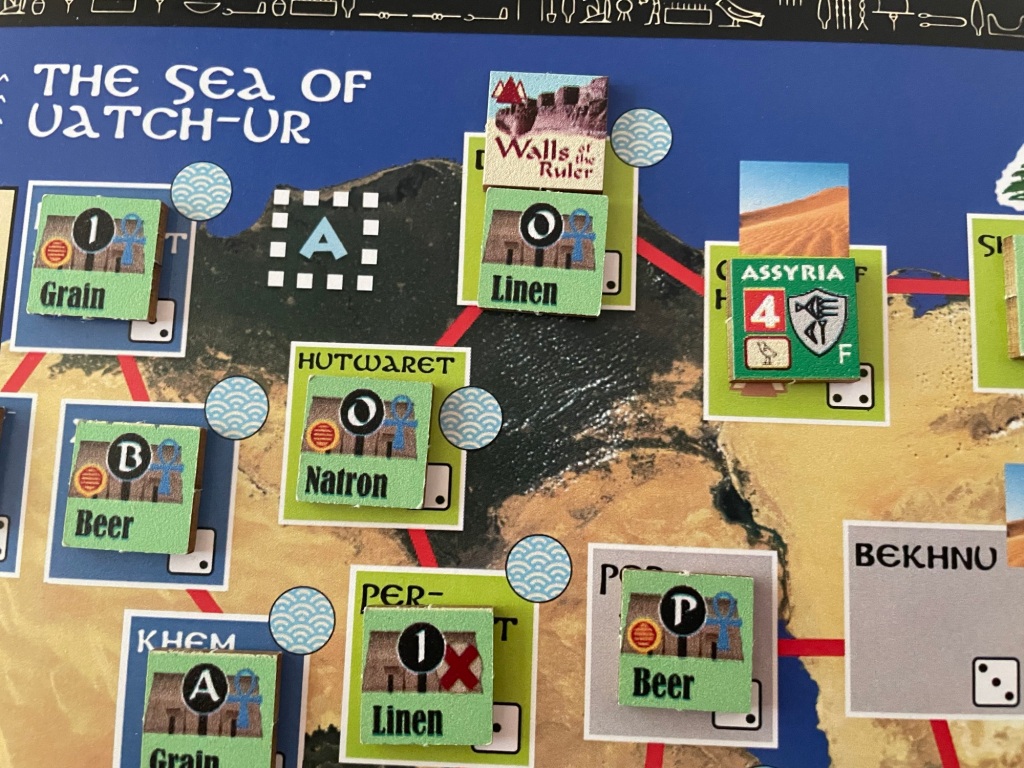
Buying Ma’at Tiles
I have shared with you several of these one shot defensive Actions, that remember I don’t recommend, but now there is a more costly Action that is recommended. This is Buying Ma’at Tiles. During Hieratic Literacy, the player can buy the 2 available Ma’at Tiles from the Counter Tray. Each of these tiles cost 5 Action Points, just 4 if the currently Dynasty has the Religious Skill. These tiles will be placed in the House of Life Box and will remain the property of the player until the end of the game. The House of Life was an institution that was to be found in Egyptian cities as a combination library, school and scriptorium. The House of Life was somewhat of an academy that taught reading and writing but also would copy books for distribution to the public. These Ma’at Tiles cannot be removed from the game but each can only be used once and must be placed into a Nile Land for a number of different actions including Templing a Sepat (you have to use the Ma’at Tile, roll a die and the result has to be higher than the printed value on the Sepat Chit to be successful), to undermine a Rival Dynasty (roll a die and the result has to be higher than the printed value on the Rival Dynasty Chit to be successful) and Boost Morale (place on a Sepat and it will block a possible revolt and any degradation from being occupied by a Khasti Army). These are generally pretty good but the first 2 are more useful than the final one.
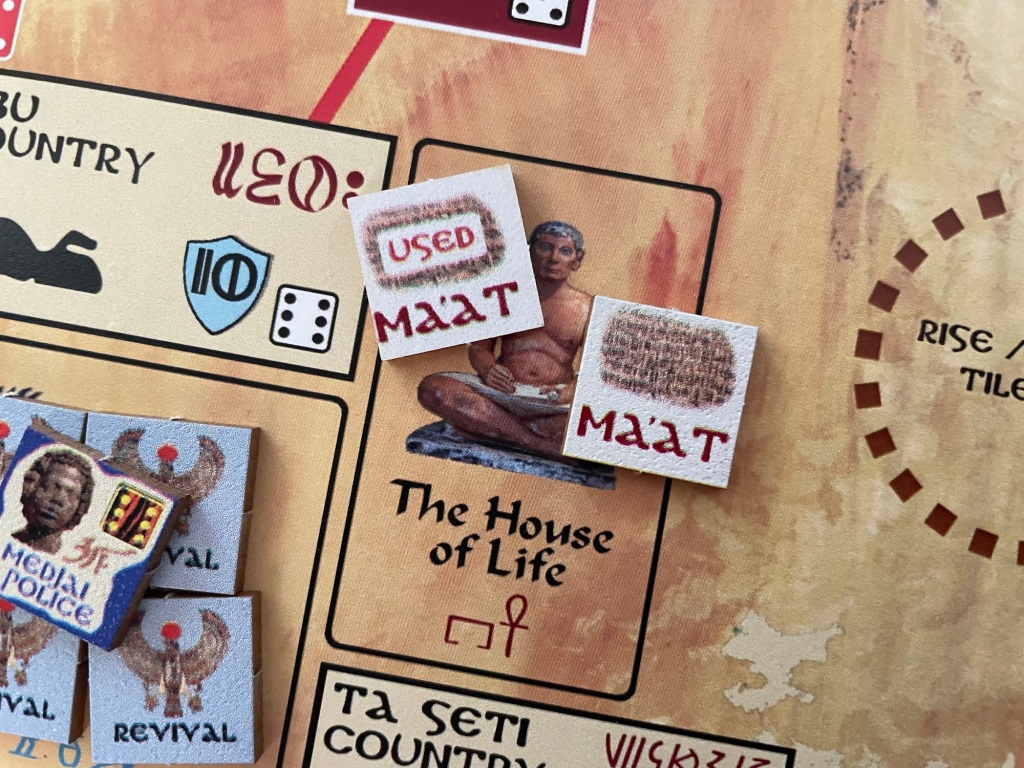
Building Heroes
There are 2 different Hero units that the player can build in the game. These units represent the Nubian Archers and Mera Fleet and are elite military units that can be moved around the board to attack Khasti Armies and defend against their attacks. These heroes can only be built with the expenditure of Gold and there are typically some other conditions that must have been met. The Nubian Archers will cost 2 Gold to build while the Mera Fleet costs 4 Gold (2 Gold if the player controls Sheruhen on the Retjenu Path, which is Land Box 5 with the Tree Icon) and only after Dynasty 18 is complete. These Heroes can be moved out of the Heroes Box for 1 Action Point and do a number of things such as directly attack a Khasti Army at a +1 DRM, be placed defensively in a Land Box where if a Khasti Army moves in they get a free Attack (without the +1 DRM) or can be Reaction Moved from any space on the board to respond to a Khasti Army movement or Rival Dynasty Tile being placed at the cost of 2 Gold (or even 4 Gold to move to Men-Nefer to be the last line of defense).
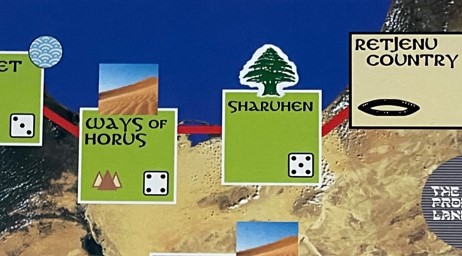
Heroes are a vital part of any solid defensive plan and are best used in that defensive role as you only have to spend the Action Points to get the units where you want them and then they lay in wait to defend against an incursion. Doing the other Actions is very costly but it is nice to have them as an option when things are dire but Gold is scarce and as things get worse, you will have less and less Gold and will be unable to truly utilize these Heroes in the Reaction Moves often.
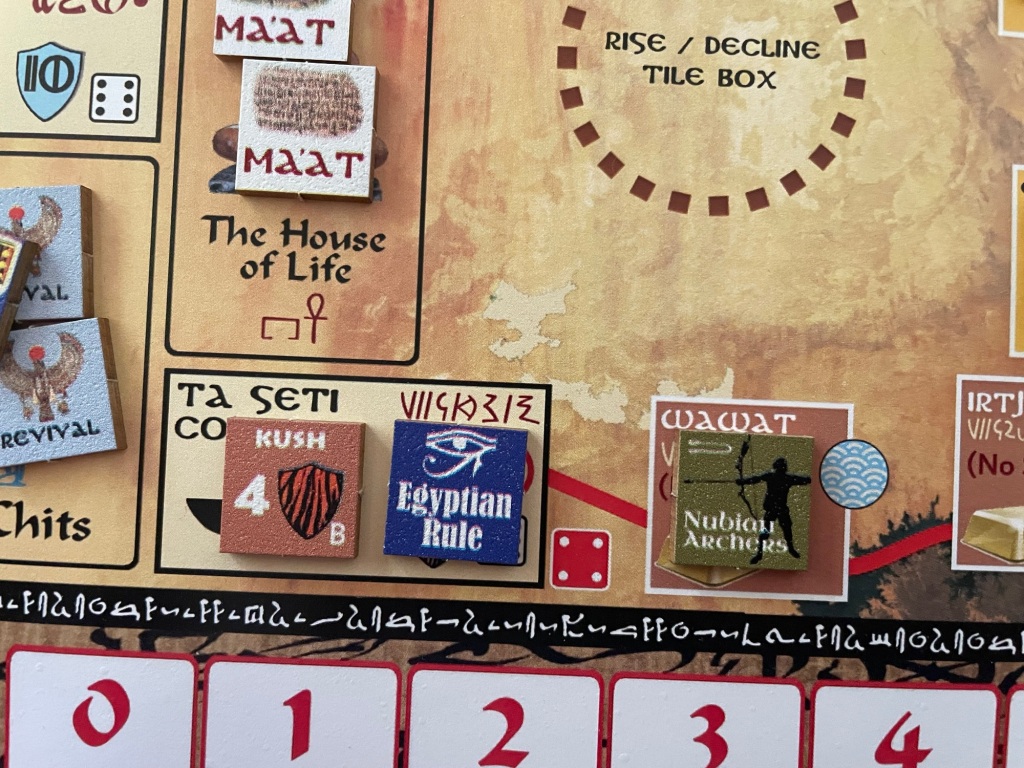
Advance Literacy
One of my favorite elements that was included in the game was the concept of the literacy of the people of Egypt and how this level allows or doesn’t allow further advancements in certain areas of development of the civilization and culture. This is found in the access to certain Actions that the players can or cannot take depending upon their current investment into the Literacy Track. There is an Action to increase the track called Advance Literacy. This costs 5 Action Points (only 4 AP if Thoth is this turn’s god) to move the Literacy Tile one box to the right on the Literacy Track. The Track starts in Hieroglyphic but can then be advanced one box at a time to Hieratic, Demotic and finally Coptic. This is a big investment but is definitely an important investment as many Actions cannot be accessed until you have reached the required level of literacy. One of the most important of these is the Invading a Country Action that we discussed earlier. This is one of the best parts of the design and I really appreciate its inclusion in the game.
If the player reaches the Coptic level of literacy before the end of the game, this will be worth 5 Survival Points. This is important but the real value is the Actions that are unlocked throughout the game.

There are some other more obscure Actions that I didn’t cover here, such as Borrowing from the Romans or Plundering Greeks and Jews, but each of these Actions has a very important purpose and function and a mastery of each of them is critical to doing well in the game. As you play, you will discover the utility for each of the Actions but some will become more important than others and you have to make wise choices about how and when to use the Actions and whether to pay their investment costs or not. This is one of my most favorite parts of the design…the choices that are forced upon you and the difficult decisions you will be faced with managing scarce and shrinking resources while trying desperately to fend off your enemies while simultaneously making progress in key areas such as literacy and the construction of Megaprojects.
I wrote a fairly in-depth First Impressions style post that you can read at the following link: https://theplayersaid.com/2024/04/03/first-impressions-gift-of-the-nile-the-rise-fall-of-ancient-egypt-from-white-dog-games/
We also posted an interview with the designer and you can read that on the blog at the following link: https://theplayersaid.com/2024/03/11/interview-with-r-ben-madison-designer-of-gift-of-the-nile-the-rise-fall-of-ancient-egypt-from-white-dog-games/
In Action Point 6, which is the conclusion to the series, we will review some strategy pointers on how to do well at the game.
-Grant
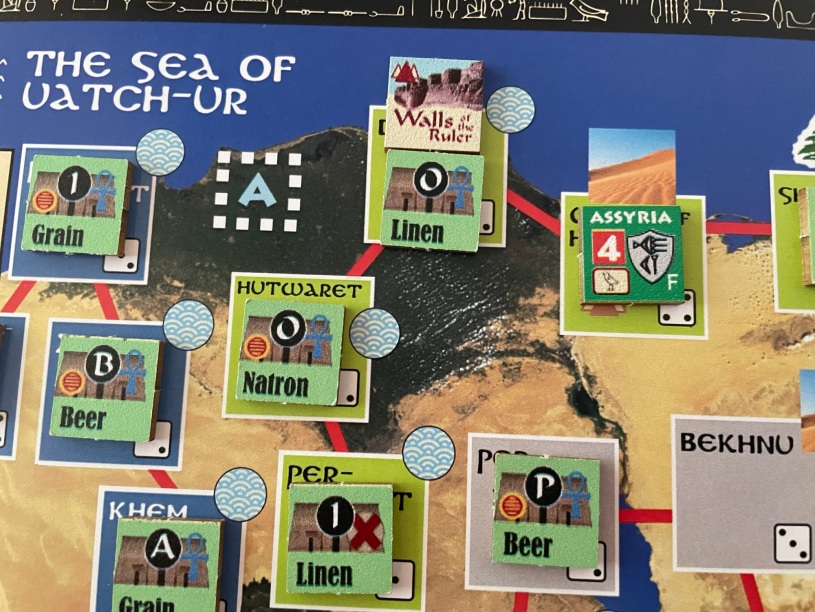
Thank you!! Thank you!! Thank you!!Thank you!! for writing these descriptive blogs about this game. I have started playing and as I go through the rulebook I think I know what it means as I’m moving and drawing tiles but continually question myself. These writeups are excellent!
LikeLiked by 1 person
Thanks. Part 6 comes out next week. That’ll wrap up the series. It’s been fun writing it and playing the game.
LikeLike